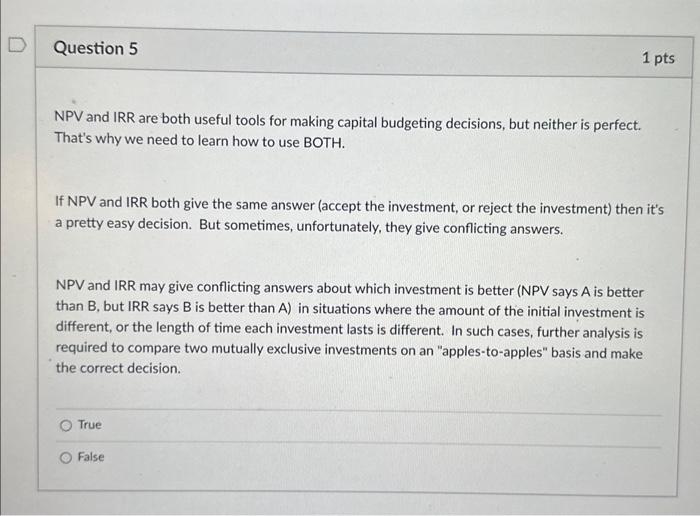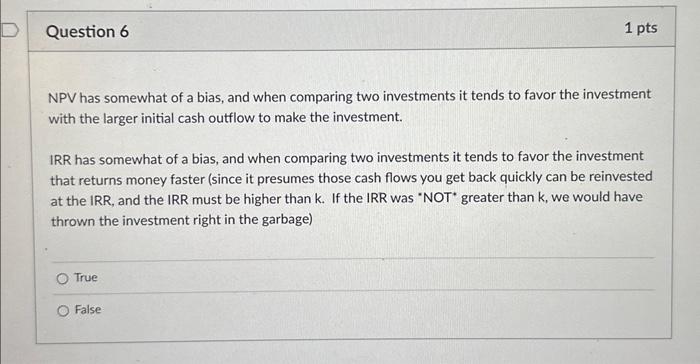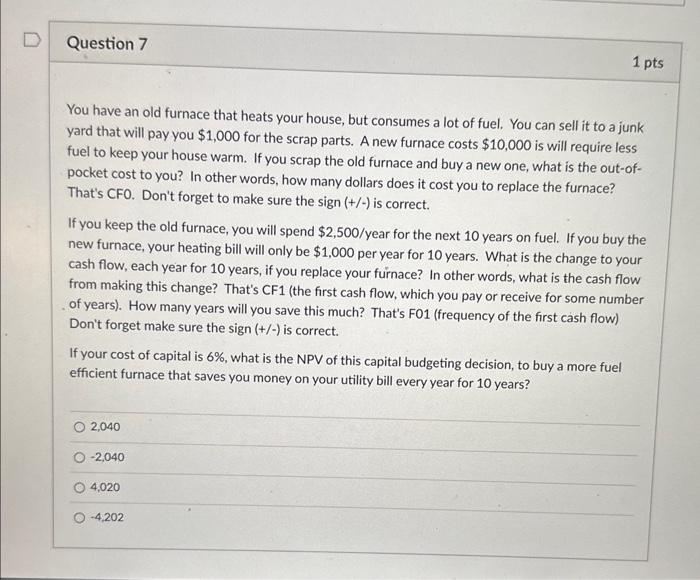NPV assumes that any intermediate cash flows you receive are reinvested at the firm's cost of capital (k), just like the YTM for a bond assumes that any intermediate cash flows are reinvested at the YTM. IRR assumes that any intermediate cash flows you receive are reinvested at the IRR, rather than the firm's cost of capital (k). True False NPV and IRR are both useful tools for making capital budgeting decisions, but neither is perfect. That's why we need to learn how to use BOTH. If NPV and IRR both give the same answer (accept the investment, or reject the investment) then it's a pretty easy decision. But sometimes, unfortunately, they give conflicting answers. NPV and IRR may give conflicting answers about which investment is better (NPV says A is better than B, but IRR says B is better than A) in situations where the amount of the initial investment is different, or the length of time each investment lasts is different. In such cases, further analysis is required to compare two mutually exclusive investments on an "apples-to-apples" basis and make the correct decision. True False NPV has somewhat of a bias, and when comparing two investments it tends to favor the investment with the larger initial cash outflow to make the investment. IRR has somewhat of a bias, and when comparing two investments it tends to favor the investment that returns money faster (since it presumes those cash flows you get back quickly can be reinvested at the IRR, and the IRR must be higher than k. If the IRR was "NOT' greater than k, we would have thrown the investment right in the garbage) True False You have an old furnace that heats your house, but consumes a lot of fuel. You can sell it to a junk yard that will pay you $1,000 for the scrap parts. A new furnace costs $10,000 is will require less fuel to keep your house warm. If you scrap the old furnace and buy a new one, what is the out-ofpocket cost to you? In other words, how many dollars does it cost you to replace the furnace? That's CF0. Don't forget to make sure the sign (+/) is correct. If you keep the old furnace, you will spend $2,500 /year for the next 10 years on fuel. If you buy the new furnace, your heating bill will only be $1,000 per year for 10 years. What is the change to your cash flow, each year for 10 years, if you replace your furnace? In other words, what is the cash flow from making this change? That's CF1 (the first cash flow, which you pay or receive for some number . of years). How many years will you save this much? That's F01 (frequency of the first cash flow) Don't forget make sure the sign (+/-) is correct. If your cost of capital is 6%, what is the NPV of this capital budgeting decision, to buy a more fuel efficient furnace that saves you money on your utility bill every year for 10 years? 2,040 2,040 4,020 4,202










